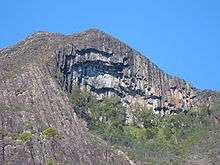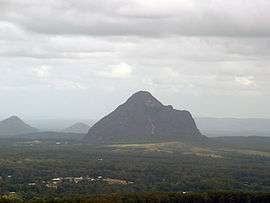Mount Beerwah
| Mount Beerwah | |
|---|---|
|
Mount Beerwah viewed from Mary Cairncross Reserve | |
| Highest point | |
| Elevation | 556 m (1,824 ft) |
| Coordinates | 26°54′S 152°53′E / 26.900°S 152.883°ECoordinates: 26°54′S 152°53′E / 26.900°S 152.883°E |
| Geography | |
 Mount Beerwah | |
| Parent range | Glass House Mountains |
| Geology | |
| Age of rock | 26 million years |
| Mountain type | Volcanic |
| Climbing | |
| First ascent | Andrew Petrie and John Petrie |
Mount Beerwah is the highest of the ten volcanic plugs in the Glass House Mountains range, 22 km north of Caboolture in South East Queensland, Australia. It was formed 26 million years ago during the Oligocene Epoch of the Paleogene Period. Geologists estimate it may have been three times the height before it was eroded to a volcanic plug.
Mount Beerwah has two peaks, the taller of which is 556 metres (1,824 ft) high. It is one of the most visually prominent mountains in south-east Queensland. The first white person to ascend the peak was Andrew Petrie with his son John Petrie.[1] Its name comes from the Dungidau language words "birra, or "sky," and "wandum," "climbing up."
In the traditional Aboriginal story of the region, Mount Beerwah is the pregnant mother and Mount Tibrogargan the father of all the other mountains in the area. Local aboriginals consider the mountains sacred.
The mountain is basically a column of trachyte. One side features a dramatic, inward leaning cliff face known as the Organ Pipes.[1] At its base is a number of small caves.
Climbing

It is legal to climb all mountains in the Glasshouse National Park. Mount Beerwah along with Mount Tibrogargan, Ngunngun and the rest of the mountains with tracks remain open with maintained walking trails; the views from the summit of Mount Beerwah are however very rewarding. There is a 2.6 km trail up from a state government maintained parking lot.[2] The start of the trail is a "level 5 difficulty" walk[3] that turns into a climb that can be done without equipment. Even experienced hikers should not attempt this trail unless they have at least three hours of daylight and there is no chance of rain. Depending on fitness, climbers should plan on taking two to three litres of water per person.
Public Access
As of 1 January 2016 all public access has been reopened and barriers removed from the route by QPWS. The route has been deemed safe to climb after the rock fall site has stabilized. Mount Beerwah summit trail was controversially closed to climbing from 2009 - 2016, due to rock instability from bush fire. The Sunshine Coast council spent $400,000 on removing dangerous rocks and improving warning signs. http://www.sunshinecoastdaily.com.au/news/debris-removal-sees-glasshouse-mountains-walking-t/2693189/
See also
References
- 1 2 Horton, Helen (1988). Brisbane's Back Door: The story of the D'Aguilar Range. Bowen Hills, Queensland: Boolarong Press. pp. 142—144. ISBN 0-86439-036-X.
- ↑ "Mount Beerwah Track". queenslandholidays.com.au. Tourism Queensland. Retrieved 5 May 2011.
- ↑ "Mount Beerwah summit route—temporary closure". Queensland Government. 13 November 2014. Archived from the original on 4 September 2015. Retrieved 4 September 2015.
External links
![]() Media related to Mount Beerwah at Wikimedia Commons
Media related to Mount Beerwah at Wikimedia Commons
